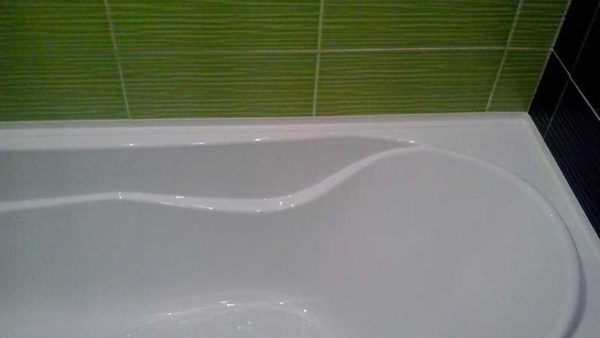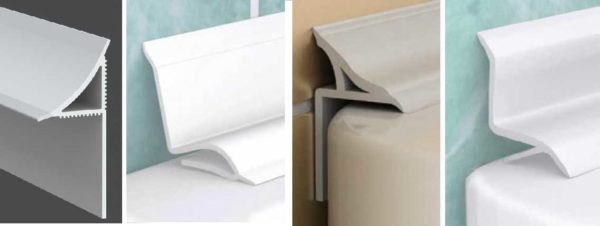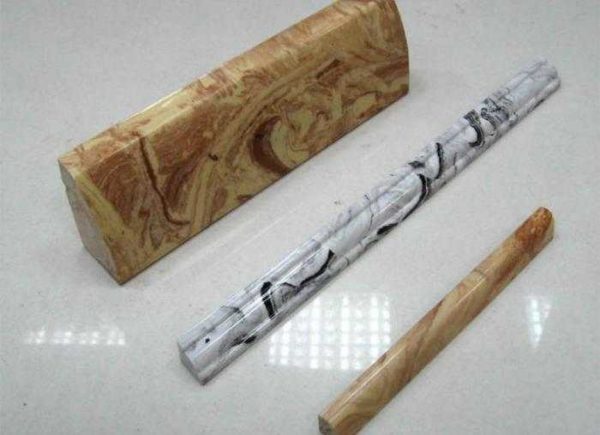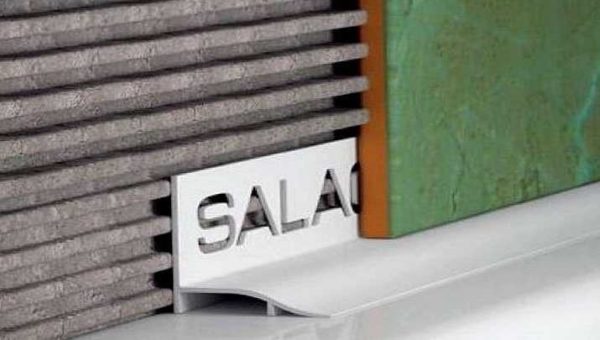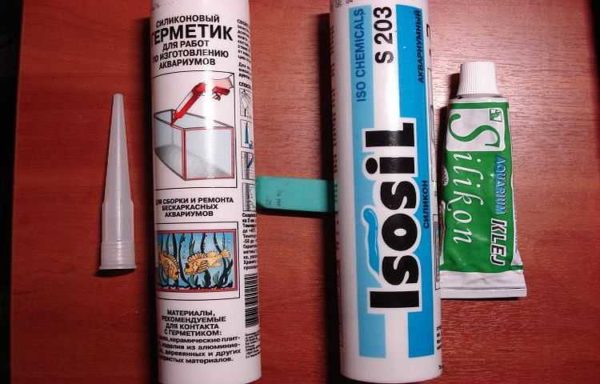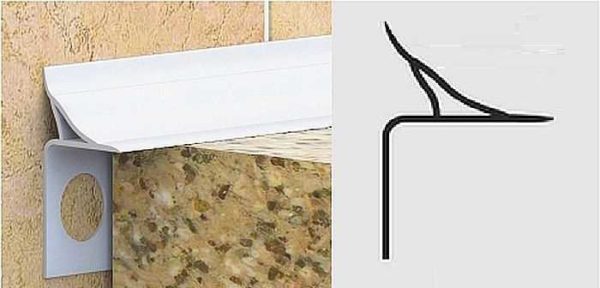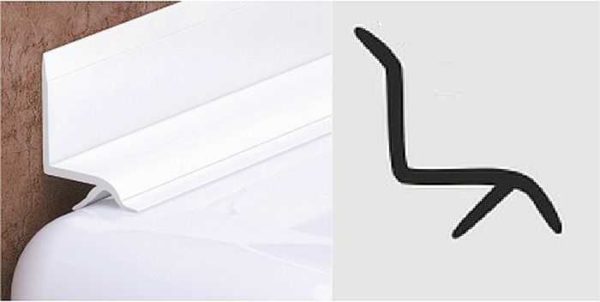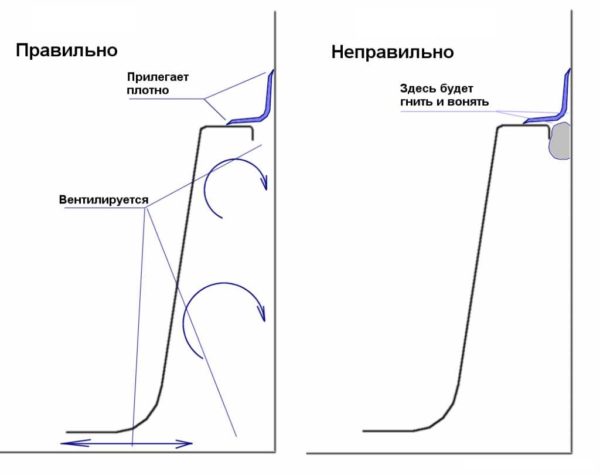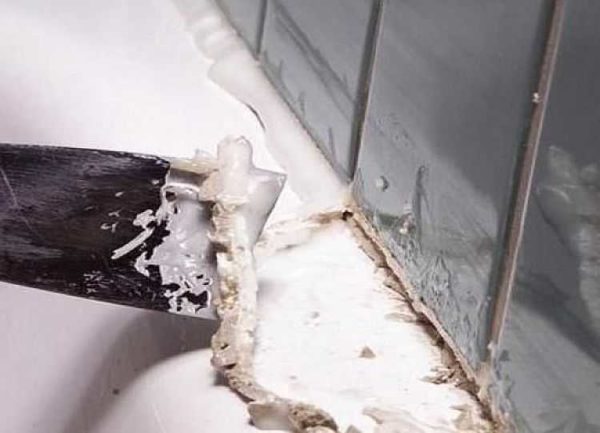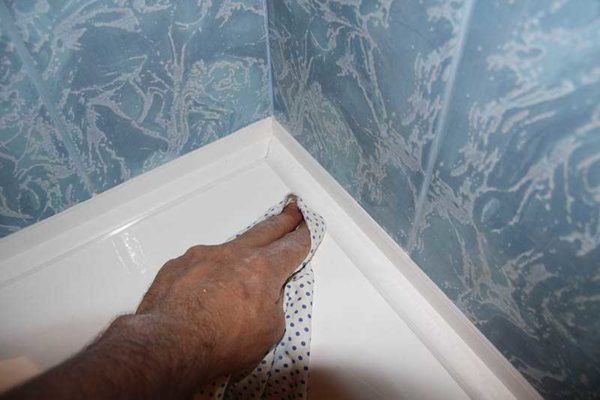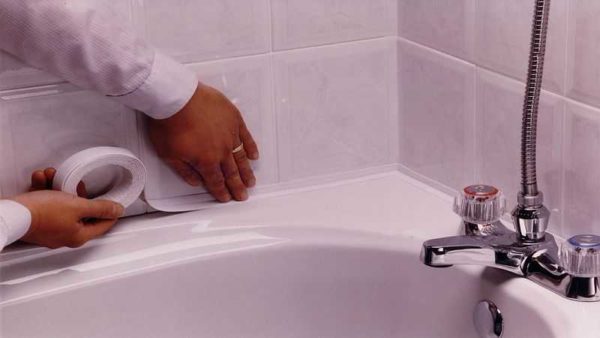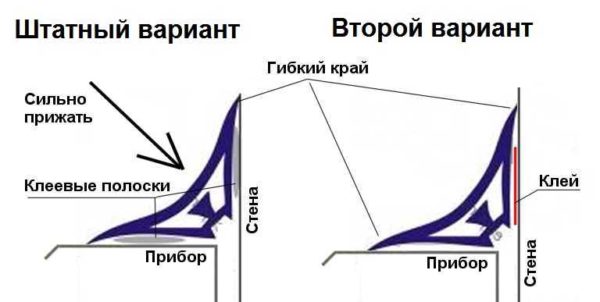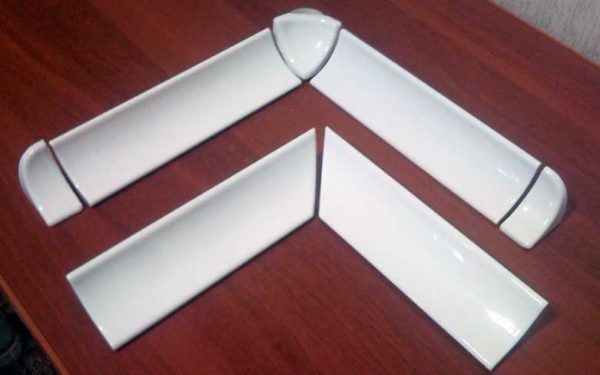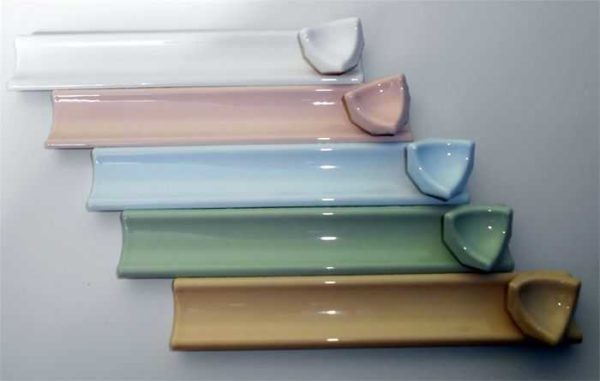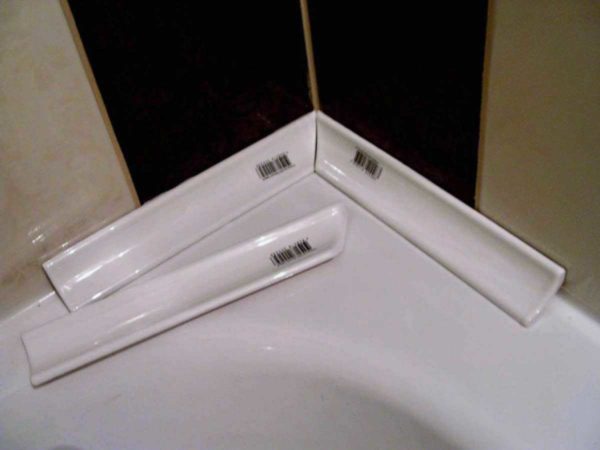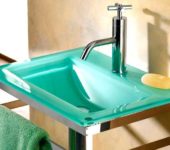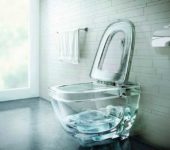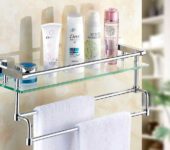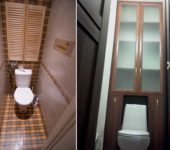What can be a bath curb, how to mount it
After installing a bathtub, shower tray, sink or washbasin, a gap remains between the side of the stantechpribor and the wall. Sometimes it is only a few millimeters, but water still gets there, flows along the wall to the floor and, if the degree of sealing is insufficient, it can "please" the neighbors from below with a dark spot on the ceiling. Even if you live on the ground floor or in a private house, dampness under the bathroom will not bring anything good - mold and mildew, a musty smell. Therefore, they try to close these gaps. There are numerous and varied bathtub curbs that cover this gap. They are placed not only on bathtubs, but also on trays in the shower room or near the sinks. They just choose a different profile and its sizes. The installation principles remain the same.
The content of the article
The gap between the wall and the bathroom and the choice of the border
If the bathtub was installed after finishing the walls, a gap inevitably remains between its side and the wall. Large or not very - depends on how smooth the walls are and whether the bath itself is evenly exposed. In any case, it is better to close this gap. Firstly, there will be no dampness under the bathroom, and secondly, the appearance is better.
To choose a border for a bath, one must proceed from the width of the gap. Depending on the distance to the wall, the installation sequence changes:
- If the distance between the bathroom and the wall is up to 3 cm, you can immediately install the side. Only its bottom shelf should be wide - it should be 3 times wider than the slot. And yet - in this case, only hard corners are suitable - ceramic or plastic. It is better to glue the curb tape with a small gap of several millimeters or pre-seal it with a cement-sand mixture.
- If the distance from the rim to the bath is more than 3 cm, it must first be repaired. There are three options:
- Attach the formwork from below, pour concrete, after setting (at least three to four days), you can continue to work.
- Close the gap with moisture resistant plasterboard in two layers. A frame is assembled, which is attached to the wall with dowels, and to the bathtub - with mounting foam or liquid nails. If the shelf turns out to be large, they put vertical supports. In general, a full-fledged frame is assembled. A corner or ceramic tile can be mounted on a fixed drywall if the gap is very large and the width of the corner is not enough to close it.
- Make a skirting from the same tiles as the walls. The variant is familiar from the past years, but today it is already unpopular.
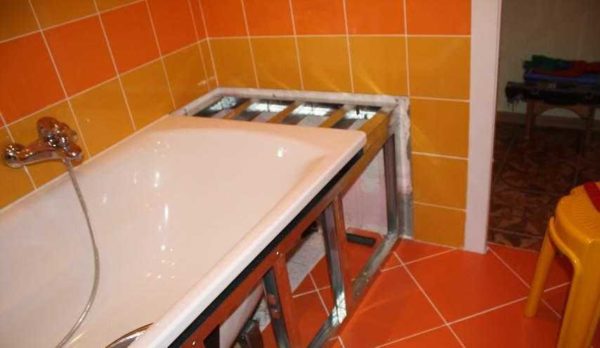
Assemble the frame from the metal profile and sheathe it with moisture-resistant plasterboard. You can combine it with a frame for bath screenat
Having decided on the technology for sealing the gap, you can choose a bath border. It's not as easy as it sounds - there are many different options, so you can get lost.
How to restore the coating of an old bath, read here.
Types of bath curbs and their installation
All bathroom curbs can be divided into two large categories, each of which has several subspecies:
- polymer and PVC:
- plastic (PVC) bath borders;
- plastic corners;
- self-adhesive tape;
- foam or polyurethane (ceiling) curbs.
- from mineral raw materials:
- ceramic:
- marble:
- granite.
Products from the first group are more affordable in price, they are easier to install. Ceramic, marble or granite curbs are more expensive and difficult to install, but they also look much more colorful. True, bathroom design should also be appropriate.
Installation of plastic borders and corners
When it comes to plastic bath borders, they can be installed under tiles and on tiles (or any other wall finish). The border on the bathroom floor tile is installed in the process of wall decoration - its upper edge is placed under the tile. This option is good, but it is impossible to move / replace the bath without destroying the finish.
The second type of curbs is installed after finishing work. In this case, the bathtub is simply attached to the wall, and the existing gap is closed with one of the plastic or polymer corners.
Plastic borders installed on tiles are available in different profiles, with different shelf sizes. The sides of these products themselves are elastic and they fit snugly against the wall and plumbing fixtures. The usual finishing plastic corner is more rigid. It can be hermetically installed only on a smooth wall - not on tiles and, moreover, not on embossed tiles. For such cases, there is a PVC skirting board with rubber sides. The rubber edges of this curb fit snugly even in the seams between tiles and in the relief. Where the adhesion is not tight enough, glue or sealant "works".
What adhesive sealant to use
In most cases, the bath curb is fitted with silicone sealant. But then problems arise: after a while the seam becomes dark - mold develops. You have to remove everything, disinfect, degrease and put in place. The interval between the normal state and the appearance of mold is different for everyone - from a year to several months. It depends on the intensity of use, but more on the availability of sufficient ventilation in the bathroom. If ventilation is poor, it can bloom within a few months.
There is an exit. And not even one:
- You can use an aquarium sealant. It does not bloom under any conditions (perhaps it contains antibacterial components). Like ordinary plumbing, aquarium sealant is white and transparent. Only the packing is usually small and the price is higher. But it's worth it.
- Waterproof glue. Anyone but good and reliable. If you need an example - Moment Crystal. Inexpensive, reliable. But one point: you must use it strictly according to the instructions. Then it keeps for a long time, and fungi and mold will not start on it.
- A good (read expensive, proprietary) MS polymer based sealant. It is really hydrophobic and continues to repel water even after years, while regular acrylic starts to flow after 4-6 months. Among the MS polymer sealants, there are compositions with antibacterial components that prevent the development of fungi and mold. After drying, they remain elastic, therefore they tolerate minor movements of cast-iron or metal baths without problems.
How to glue so as not to fall off
Many have already used the bath curb more than once, but every time problems arise - after a while, the corner or the baseboard falls off the wall. This happens because when using a bathtub or shower cabin, they move at least a little. You step into the container, it moves a little, go out - again the minimum, but the movement, leaning on the edge of the bath - moved again. And so every time. Naturally, if you attach the curb to the bathtub rigidly, sooner or later it will fall off. Large range of motion for acrylic bathtubs and shower trays, less for steel and cast iron. Accordingly, the plinth falls off faster from acrylic containers, the rest lasts longer.
To avoid this problem, stick the PVC border for the bath or shower tray only to the wall. This is especially true for acrylic containers. With this method of installation, a layer of glue on top prevents water from flowing into the gap between the bathroom and the wall. The lower part of the corner is firmly pressed against the side (when installing it must be pressed well), excluding the ingress of water from the side. In this case, all movements are calmly compensated by the elasticity of the material and the plinth is kept on the wall.
If this option does not suit you, look for a sealant that, after drying, remains airtight (in particular, these are the same sealants based on MS polymers). It is suitable for cast iron and steel bathtubs, the bath border will hold. For acrylic, this is, unfortunately, not an option - the progress is too great.
Why does the baseboard stink
There is another unpleasant moment that often appears after installing a PVC bath curb - an unpleasant smell from under the plastic. It is not possible to make the connection 100% tight, although microscopic gaps remain. Water seeps into them, and it remains there. After a while, the water decays, begins to exude the same smell. This happens due to the adopted technology for installing the sides for the bathroom - it is recommended to first fill the gap between the bathroom and the wall with a sealant, and then install the baseboard. The idea is clear - so that the water that gets under the baseboard does not seep under the bath. And so it happens - the water remains in the remaining gap, from where it "smells".
To avoid such a nuisance, it is better to install the bath border immediately on the wall, without filling the gap with anything. Yes, with this installation, a few drops of water can seep under the bath. But such an amount will not cause any harm; with sufficient ventilation, the moisture will dry out after a while.
The procedure for installing plastic borders for the bathroom
With all the differences in the method of mounting profiles of different types, there is a certain sequence of actions that is followed and leads to a good result. In general, you need to act like this:
- If there is an old skirting board or curb, remove it. Remains of sealant or glue are removed from the walls and side. To do this, they usually use a knife, you can wallpaper.
- Mold is often observed under the side, it is removed with a cloth soaked in any detergent, then everything is coated with antibacterial impregnation. There are a lot of them in stores, choose the one that meets your needs the most. Follow the instructions - observe the holding time, the number of layers, etc.
- After the antibacterial impregnation has dried, the wall and the side must be degreased. To do this, take a rag soaked in solvent or alcohol and wipe everything thoroughly. We are waiting for everything to dry out. The process can be accelerated with a hairdryer, no need to wipe.
- The selected border is tried on, cut to size. In the places where two segments meet, use standard corners (if there are any) or cut the corners at an angle of 45 °. Plastic can be cut with scissors for metal or cut with a hacksaw on which a blade with a fine tooth is fixed (it can be special for plastic, but it is also suitable for metal). In any case, the edge is not perfect. It is brought to a perfect match with a file or emery paper with different grain sizes, fixed on a block (when cutting off pieces, leave a few millimeters for adjustment). When you are satisfied with the result of joining the two pieces, move on to the next step.
- The subsequent actions depend on the type of selected border. They can be self-adhesive. Then you need to remove the protective tape, attach the bath curb in place and press down well.If it is just a PVC skirting board, a glue-sealant is first applied to the wall and / or to the shelves of the skirting board, after which it is installed and pressed well.
- The sealant protruding from under the plinth is immediately wiped off with a soft cloth. Do this without delay - if it hardens, it will be difficult to clean.
That's all. Bath curb installed. Now you need to wait a while until the composition hardens and grabs. The exact time depends on the type of adhesive / sealant used and can take from several hours to several days.
Using this technique, a self-adhesive (border) tape is also mounted to finish the junction of the bathroom and the wall. This is an inexpensive and quick way to close a small gap. Such a finish can only last a little less than a plastic one, but there is less fuss with it, although all stages of the preparatory work remain in force.
There is one point to remember when installing the curb on an acrylic bathtub. Before gluing, more than half of the bath is filled with water and left in this form until the sealant polymerizes.
Methods for gluing a border with duct tape and flexible (rubber) edge
It just seems like installing the adhesive strip is easy. Not at all: you must immediately put it in place, since it is unrealistic to move the plinth. Peeling off in an unsuccessful attempt is also not the best way out - some of the glue remains on the tiles and the side of the bathroom / shower tray. In general, you need to practice without removing the protective tape first.
Even if you immediately managed to put the curb in place, not everything is so rosy with this type of skirting board. The fact is that the tape on which they are attached is rather thick and even the edges tightly pressed to the wall and sides do not fit so tightly. Leakage is possible in some places, especially at the seams.
If you really like this bath plinth, you can glue it with glue / sealant. To do this, tear off the adhesive tape, apply an adhesive composition to the wrong side, put it in place, press it very well. The adhesive layer is thin, the plinth is pressed very tightly, leaks are almost excluded.
And one more thing - so that the border does not come off, you do not need to apply glue on the side that is attached to the bathtub (described above).
Installation technology for a ceramic bath curb
Ceramic curbs consist of straight, corner and end elements. The number of straight elements is calculated based on the dimensions of the bath / shower tray, corners and ends with a standard placement for a bath, two are required, for a shower tray there can be one corner. Take the number of straight elements with a small margin - for pruning.
It is advisable to inspect all elements before laying. If there is a need (they do not fit exactly, there are differences in thickness, etc.), the back side can be slightly earned with a file. It is better not to use a grinder - the chance is too great to do more harm than fix.
Installation methods
The installation method of the ceramic border depends on the wall finish and the size of the gap. If it is tile, you can use waterproof glue. If the tile is embossed or the wall is simply plastered, the installation on glue does not date the required level of tightness. In this case, mount the ceramic bath curb on a special tile adhesive for wet rooms. It is sold in bags in a dry form, before use, some of it is mixed with water until smooth.
Sequencing
The whole process consists of a sequence of steps:
- The surface is cleared of deposits and dust. If there is mold, remove it, treat the wall with an antibacterial compound, and let it dry.
- If the gap between the bathroom and the wall is more than half the width of the existing curb, it must be repaired first. Better - to make formwork from below and fill with cement mortar. The second way is to attach moisture resistant gypsum board in two layers. If the shelf turns out to be large (more than 5 cm), it must be made with a slope. It can be about 5%. So you can use the shelf (put something on it) and the water will not stagnate on it. If necessary (if the border does not cover it all), the tiles are first laid, with which the walls are finished, after which the installation of the ceramic border for the bath continues.
- Start from one of the corners. Set the angle, then two adjacent straight segments. A layer of glue is applied to the back of the curb, leveled. Installed in place, pressed, leveled.
- Then continue laying to one side. End elements are installed on the sidewalls.
The process of installing a ceramic bathroom curb is not much different from laying tiles. The actions are the same. It is necessary to align the elements in two planes - so that both the edges and the plane go smoothly and without drops.

